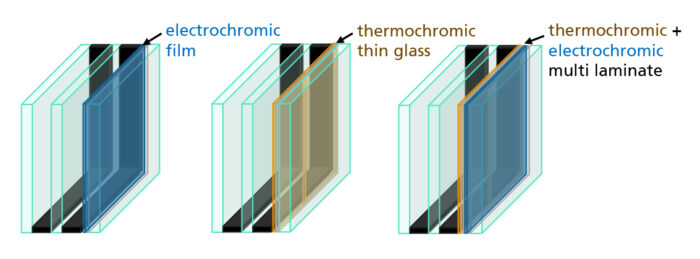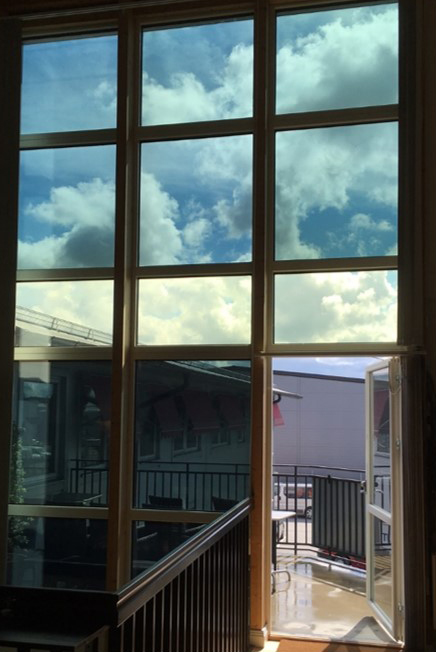About
In modern architecture, large-area glazing is a continuing trend because of its appearance and design variety. Large southwards-oriented windows help to reduce the energy demand for heating in winter. However, large-area glazing may significantly increase the energy demand for cooling and air-conditioning in hot summers. Smart Glass Solutions – such as electrochromic (EC) and thermochromic (TC) windows and glass façades – control the radiation energy transfer with the “touch of a button” and thus can drastically reduce the energy demands for heating and air conditioning of large buildings. In addition, they allow superior indoor lighting comfort in contrast to conventional mechanical window blinds.
OBJECTIVES
The EU-funded initiative Switch2Save aims to overcome these limitations by combining and maturing EC and TC systems to create lightweight Energy Smart Insulating Glass Units (IGUs) suitable for large windows and glass façades. EC switching relies on materials that change their light transmittance by applying a low electrical voltage; TC cells are based on materials that change their infrared reflection properties with increasing temperature.

The project has following specific objectives:
- Develop a combination of EC and TC cells – with optimized maximum energy saving potential – based on a switchable total energy transmittance (g-value).
- Scale the manufacturing technologies for increased availability and cost effectiveness.
- Assess the performance of the innovative insulating glass units.
- Demonstrate the heating and cooling energy saving potential and the lighting comfort in two operational buildings in Greece and Sweden.
- Replace 50 windows and 200 m² glass façade area with the smart glass solution and perform a full “beforeafter” comparison of the energy demand for a one-year cycle.
IMPACT
Switch2Save will accelerate the widespread implementation of energy smart glass and significantly contribute to the goal of a CO2 neutral building stock in the EU before 2050.

PUBLIC DELIVERABLES
List of public deliverables will be available here including link to their content (as soon as they are approved by the European Commission).
SWITCH2SAVE FACTS
Project Acronym:
Switch2Save
Project full title:
Lightweight switchable smart solutions for energy saving large windows and glass facades
Grant Agreement no.:
869929
Start date:
01/10/2019
End date:
30/09/2023
Duration in months:
48
Project funding:
5.5 M€ requested EU contribution
Funding scheme:
Innovation Action
Funding programme:
Horizon 2020
Call identifier:
H2020-NMBP-EEB-2019, Integration of energy smart materials in non-residential buildings (IA)
Free keywords:
Production technology, process engineering, windows, electrochromic cells, thermochromic cells, glass facades, energy smart insulating glass units
Abstract:
Between 25 and 60% of total energy transfer through building envelopes is driven by glass based components such as windows, glass facades and glass roofs. In winter, heating energy demand of buildings with high windows to-wall ratio (WWR) in north- and east direction is up to 35% higher compared to buildings with only small windows. In summer, large windows and glass facades result in high heating of the building interior: cooling energy demand is increased by a factor ≈ 1.5 to 5 when WWR increases from 10% to 90%. Non-residential buildings often make use of large windows or glass facades for building-functional and representative reasons and therefore hardly suffer from increased energy demand. Switch2save targets active management of radiation energy transfer through glass-based building envelopes by integrating transparent energy smart materials with switchable total energy transmission values (g-value). Such materials are electro-chromic (EC) or thermo-chromic (TC) systems. Intelligent switching of those allows significant reduction of both heating energy demand in winter and cooling energy demand in summer. Switch2save’s unique and lightweight combined EC and TC smart insulating glass unit will be a breakthrough in performance (plus 20%); low-cost potential (minus 33% manufacturing cost) and increased design opportunities compared to state-of-the-art smart shading solutions. Switch2save prototypes will be demonstrated in two representative buildings – a hospital in Athens, Greece and an office building in Uppsala, Sweden by replacing > 50 windows and 200 m² glass façade area. Continuous monitoring of energy demand at thermal comfort levels inside the buildings for at least one year before and after TC/EC integration will verify energy saving potential of Switch2save solution. Switch2save increases the market and application potential of energy smart glass in buildings – targeting the whole building glass market of 4.7 billion square meters produced per year.